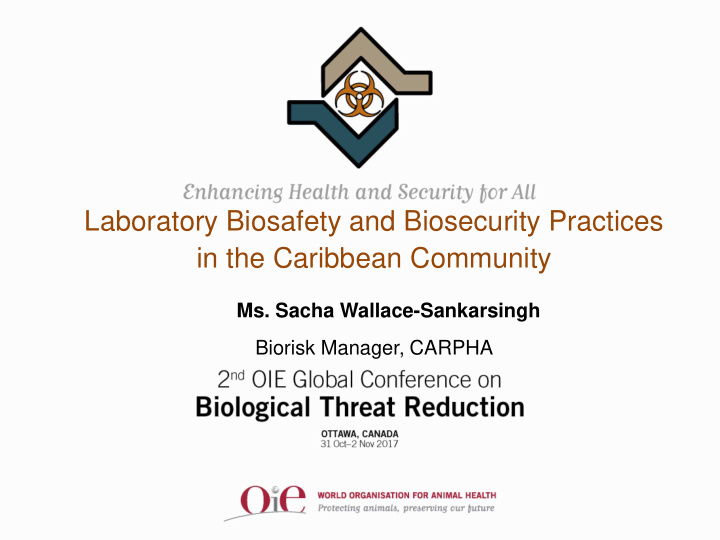



Laboratory Biosafety and Biosecurity Practices in the Caribbean Community Ms. Sacha Wallace-Sankarsingh Biorisk Manager, CARPHA
CARICOM & CARPHA
Background • 2012-2013 Initiative: Capacity building pilot project (training and implementation biorisk management system) for Biosecurity and Disease Surveillance in the Caribbean and Central America (PAHO and GPP collaboration) • Follow up survey on the “Analysis of Laboratory Capacities and Needs” conducted by CARPHA in 2015 identified biosafety and biosecurity management as a key area for improvement • The objective of the current paper is to determine the status of laboratory biosafety and biosecurity practices across sectors including veterinary facilities of the CARPHA Member States.
Methodology • Electronic questionnaire was developed to obtain information from laboratory facilities across 18 countries of the English and Dutch-speaking Caribbean from January to August 2017. • Information regarding demographics, awareness of legislative requirements, operational practices and training needs were collected.
Results • Regional dataset n= 156 (18 countries) • Veterinary dataset n= 32 (9 countries) Sectors represented by Veterinary Laboratories Sector 0 20 40 60 80 100 Trade Research Environment Education Health Food & Beverage Agriculture
Availability of Regulatory and Operational Requirements 100 80 60 Percentage 40 20 0 National Legislation Registered/licensed QMS implemented Laboratory Safety Biorisk management exists Officer assigned policy Vet Regional
Physical Containment and Use of Laboratory Equipment Containment Conditions of Veterinary Key Laboratory Percent Laboratories in CARICOM Equipment (%) BSC certified on annual 19% basis 21 47% Centrifuges with sealable buckets used 32 34% Scheduled maintenance of autoclave 36 BSL-1 BSL-2 DNK
Capacity to Detect Key Pathogens in CARICOM No. of laboratories Biological Agent Regional Veterinary Bacillus anthracis 2 0 Brucella sp.* 6 2 Escherichia coli 35 6 (shiga toxin) Influenza Virus 13 3 Mycobacterium 18 1 tuberculosis* Rabies Virus* 1 1 Salmonella sp.* 45 8 Shigella sp. 44 4 Vibrio cholerae 13 1 Yellow Fever Virus 3 1 Yersinia pestis 4 1
Percentage of Veterinary Laboratories conducting training on Key aspects of a laboratory safety programme Biosecurity practices Emergency response Spill response Waste management practices Selection and use of PPE Proper use of biosafety equipment Risk Assessment and Hazard Identification Good Laboratory Practices 0 10 20 30 40 50 60 70 80 90 100
Key Messages • Key gaps exist across sectors including for veterinary laboratories • Coordinated, integrated approach to pathogen biosafety and biosecurity required (Cari-PHLN; CaribVETNet: CariVecNet) • Context for priority disease recognition and appropriate containment measures • Regional capacity building initiatives exist for medical/public health laboratories, opportunities for scope expansion
Thank you
Recommend
More recommend